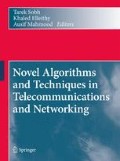Abstract
Complex networks have been an up-and-coming exciting field in the realm of interactions. With their widespread use appearing on the horizon it is ever more vital to be able to measure their vulnerability as a function of their topology. Precisely, discovering vulnerable links, disposed to attacks, can help in hardening these links and by that providing more secure and reliable network structure. This paper addresses the link vulnerability of different topologies of complex networks such as: random networks, geographic random networks, small world networks and scale-free networks. We introduce measure for vulnerability of complex networks, and prove by simulations that network vulnerability heavily depends on the network topology.
Access this chapter
Tax calculation will be finalised at checkout
Purchases are for personal use only
Preview
Unable to display preview. Download preview PDF.
Reference
M.G.H. Bell, The use of game theory to measure the vulnerability of stochastic networks. Reliability, IEEE Transactions on Volume 52, Issue 1, March 2003 Page(s): 63 – 68.
John von Neumann, Oskar Morgenstern, Theory of Games and Economic Behavior. Princeton University Press, 1944.
J. Nash, Equilibrium point in n-person games. Proceeding of the National Academy of Science, 36, 1950.
M.G.H. Bell, Mixed Route Strategies for the Risk-Averse Shipment of Hazardous Materials, Netw. and Spat. Econ., vol. 6, no.3, pp. 253–265, 2006.
H. Karaa, and J.Y. Lau, Game Theory Applications in Network Reliability in Proc. Communications, 23rd Biennial Symposium, 2006, pp. 236–239.
Satayapiwat, P.; Suksomboon, K.; Aswakul, C, Vulnerability analysis in multicommodity stochastic networks by game theory, ECTI-CON 2008, pp. 357–360.
Michael Karonski and Adrzej Rucinski: The Origins of the Theory of Random Graphs, The Mathematics of Paul Erdos, Berlin, Springer, 1997
Miligram S.: The small world problem, Psychology today 2, pp. 60–67,1967.
L.A.N. Amaral and J.M. Ottino, Complex Networks, Augmenting the framework for the study of complex systems, Eur. Phys. J. B 28, 147–162, 2004.
Albert Laszlo Barabasi: Linked, Penguin Group, London, May, 2003
P. Bork et al. “Protein interaction networks from yeast to human”, Current Opinion in Structural Biology, 14(3):292–299, 2004.
Mark S. Granovetter: The Strength of Weak Ties: A Network Theory Revisited, Sociological Theory 1, 1983
D. J. Watts: Small Worlds: The Dynamics of Networks between Order and Randomness, Princeton University Press, 2003
Malcom Gladwell: The Tipping Point, New York, Little, Brown, 2000
Albert B., Barabasi A.L.: Statistical mechanics of complex networks, Reviews of modern physics, Vol. 74, January 2002.
Mathew Penrose: Random Geometric Graphs, Oxford University Press, New York, 2004
E. W. Dijkstra: A note on two problems in connexion with graphs. In Numerische Mathematik, 1 (1959), S. 269–271.
THE MATHWORKS, INC. 1997. MATLAB: The Language of Technical Computing. The MathWorks, Inc. Using MATLAB (Version 7).
Keith Briggs, Graph eigenvalues and connectivity, july 2003.
Borgatti, S., Everett, M. & Freeman, L. (1996a). UCINET IV Version 1.64. Natick, MA: Analytic Technologies.
Freeman, L. C. (1979). Centrality in social networks: Conceptual clarification. Social Networks, 1(3), 215–239.
Sonja Filiposka, Dimitar Trajanov and Aksenti Grnarov, Survey of Social Networking and Applications in Ad Hoc Networks, ETAI 2007, Ohrid, R.Macedonia, 2007.
Author information
Authors and Affiliations
Corresponding author
Editor information
Editors and Affiliations
Rights and permissions
Copyright information
© 2010 Springer Science+Business Media B.V.
About this paper
Cite this paper
Igor, M., Filiposka, S., Gramatikov, S., Trajanov, D., Kocarev, L. (2010). Game Theoretic Approach for Discovering Vulnerable Links in Complex Networks. In: Sobh, T., Elleithy, K., Mahmood, A. (eds) Novel Algorithms and Techniques in Telecommunications and Networking. Springer, Dordrecht. https://doi.org/10.1007/978-90-481-3662-9_36
Download citation
DOI: https://doi.org/10.1007/978-90-481-3662-9_36
Published:
Publisher Name: Springer, Dordrecht
Print ISBN: 978-90-481-3661-2
Online ISBN: 978-90-481-3662-9
eBook Packages: EngineeringEngineering (R0)

